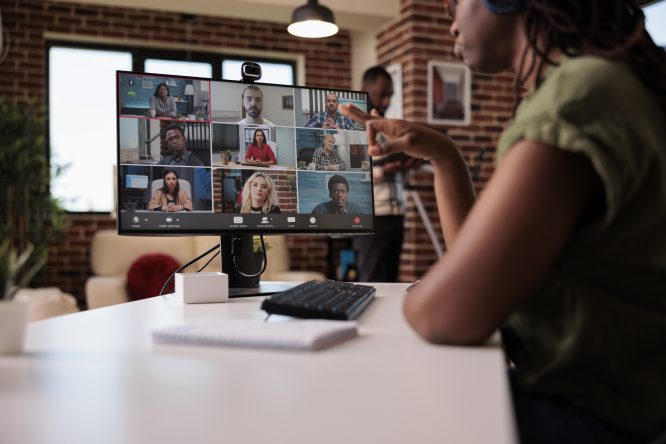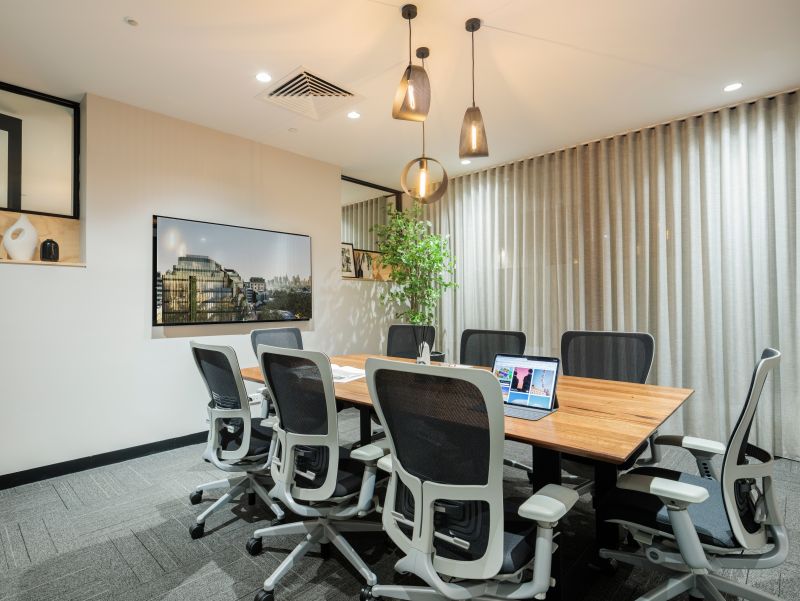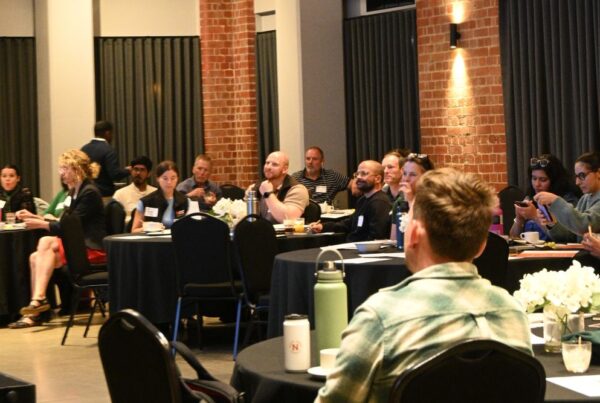
Corporate meetings are a cornerstone of organizational life, providing a platform for announcements, recognizing achievements, discussing changes, and strategizing plans. An effective corporate meeting hinges on four key components: Purpose, Product, People, and Process. Looking ahead, several emerging trends are set to redefine how corporate meetings are conducted, making them more inclusive, efficient, and technologically advanced. In this article, United Co. compiles the five trends that will shape the future of corporate meetings.
What is the importance of corporate meetings?
Corporate meetings can be held to make announcements, recognize a job well done, let everyone know of changes, or discuss plans and operational strategies. A meeting is conducted when you have two or more participants in the same room sharing a discussion relevant to the organization.
Purpose, Product, People, and Process are all required to run an effective meeting. The purpose of the meeting should be clear and well-defined. This ensures all participants understand the objectives and can work towards achieving them. The product or outcome of the meeting should also be defined in advance so that everyone knows what is expected of them and what they need to contribute. The people involved in the meeting should be given a clear role and responsibility and their expertise and knowledge should be leveraged to contribute to the meeting’s discussion and success. The process or structure should be well organized and should have a clear agenda. The process of the meeting should also be flexible enough to accommodate changes and challenges that may arise during the meeting.
Read More About Why are Face-to-face Meetings at Work Still Important?
There are 3 kinds of corporate meetings.
- Information. This is a meeting where attendees are informed about what is happening. It could be a regular update meeting where team members discuss progress, achievements, and challenges about ongoing projects. Alternatively, management could also inform employees about company-wide developments, such as restructuring, new policies, or strategic changes.
- Discussion. This is a meeting where the leader wants feedback direction or connections. The purpose of these meetings is to allow participants to come together to exchange ideas, opinions, and feedback on a particular topic or issue to reach a consensus or the making of a decision.
- Permission. These meetings may refer to a distinct type of corporate meeting or conversation where one person seeks permission from another person or group to take action or make a decision. Alternatively, a project manager might seek permission from a client to make changes to a project scope or timeline.
What happens at a corporate meeting?
Corporate meetings are those business-oriented meetings that happen between business colleagues to evaluate and plan current and future business activities. The business colleagues can be from the same organization or groups of stakeholders with an interest in the subject matter of the meeting. The goal of the corporate meeting is to facilitate communication, collaboration, and decision-making within the organization.
During a corporate meeting, attendees may discuss a variety of topics relevant to the organization, such as project updates, financial reports, or strategic plans. The meeting may begin with an opening statement from the meeting leader, followed by presentations or reports from various members of the organization. Attendees may then engage in discussion, Q&A sessions, and decision-making processes. The meeting may conclude with a summary of key takeaways and any next steps identified during the meeting.
What makes effective meetings?
An effective meeting brings a thoughtfully selected group of people together for a specific purpose, provides a forum for open discussion, and delivers a tangible result: a decision, a plan, a list of great ideas to pursue, and a shared understanding of the work ahead.
Effective meetings are those that are well-planned, well-executed, and achieve their intended goals. Here are some key factors that can contribute to an effective meeting:
- Clear purpose and agenda: Helps to ensure all attendees are prepared and can contribute meaningfully and effectively to the discussion.
- Participation and engagement: Structure allows for open dialogue and discussion, with opportunities for questions, comments, and feedback.
- Time management: The meeting leader should keep the discussion focused and on topic, to keep the meeting effective within the allotted time.
- Follow-up: After the meeting, following up ensures that attendees are on track with what was discussed in the meeting. This ensures progress is made and that the meeting has meaning.
Read More About 17 Ideas To Attract More People To Your Corporate Events
Following up after a corporate meeting is important to ensure that the decisions made during the meeting are implemented effectively and that progress is made on any action items. Here are some steps you can take to follow up after a corporate meeting:
- Document decisions and action items: Document all decisions made during the meeting and any action items assigned to specific individuals or teams. Assign due dates for each action item.
- Share meeting minutes and summaries: Share meeting minutes and summaries of decisions made with all participants to ensure that everyone is on the same page and has a clear understanding of the decisions made and any action items assigned.
- Follow up with individuals or teams responsible for action items: Follow up with individuals or teams responsible for action items to ensure that they are making progress and that the action items are completed by the assigned due dates.
- Evaluate the effectiveness of the meeting: Evaluate the effectiveness of the meeting by gathering feedback from participants. Ask them what worked well and what could be improved for future meetings.
- Make changes and improvements: Use the feedback received to make changes and improvements for future meetings. For example, adjust the meeting format, change the timing or duration, or invite different participants.
- Monitor progress: Monitor progress on the action items assigned during the meeting and provide updates to all participants. This will help to ensure that progress is being made and that the decisions made during the meeting are implemented effectively.
To run successful and efficient meetings, you need to engage the entire team. Below are some things you may wish to avoid when it comes to having effective meetings.
- Mistake #1: Too Many Meetings. …
- Mistake #2: No Direction or Meeting Agenda. …
- Mistake #3: Arriving Late and Finishing Late. …
- Mistake #4: Using Cell Phones. …
- Mistake #5: No Ground Rules. …
- Mistake #6: Lack of Participation.

5 trends that Will Shape the future of Corporate Meetings
How do you handle a corporate meeting?
Handling a corporate meeting can be a complex task that requires careful planning and execution. By planning, you can define the purpose of your meetings allowing your members to plan effectively and efficiently. By setting the tone, you can encourage your team to participate and engage in open dialogue. Use active listening techniques to ensure all voices are heard and valued. Staying on track will keep the discussion focused and using time management techniques will ensure all agenda items are covered within the timeframe set out for the meeting.
Summarizing the discussion and any decisions that were made in the meeting allows for unanimous communication. Assigning action items and following up with attendees to ensure progress is made is an effective way of monitoring the progression of the meeting. Effective meeting handling can support collaboration, communication, and progress toward organizational goals.
5 Trends that Will Shape the Corporate Meetings
The evolving landscape of work has transformed the way we conduct meetings and accelerated the adoption of virtual platforms. These types of meetings will likely continue to be a popular option in the future. However, in-person meetings are also likely to remain important for many organizations. Here are five trends that are likely to shape the future of corporate meetings.
1. Hybrid meetings
Hybrid meetings, which combine in-person and virtual elements, are likely to become more popular. This will enable organizations to reach a wider audience and accommodate participants who are unable to attend in person. This trend is likely to continue in the future as more organizations seek to accommodate remote workers and reduce travel costs.
One of the primary benefits of hybrid meetings is that they enable organizations to reach a wider audience, regardless of their location. Participants can attend the meeting from anywhere in the world, as long as they have access to a laptop and a stable internet connection. This makes it easier for organizations to collaborate with partners, customers, and other stakeholders who are located in different parts of the world.
Another benefit of hybrid meetings is that they can accommodate participants who are unable to attend in person due to scheduling conflicts, travel restrictions, or other reasons. This can help to increase participation and engagement in meetings, as more people can attend and contribute their ideas and perspectives. Hybrid meetings also offer flexibility in terms of logistics and cost. Organizations can save on travel and accommodation expenses by allowing some participants to attend virtually, while still providing an opportunity for in-person networking and collaboration.
This can be especially useful for large events or conferences, where the cost of travel and accommodations can be significant. Overall hybrid meetings offer several benefits for companies including increased reach, flexibility, and cost savings. As technology continues to advance and remote work becomes more common, hybrid meetings will likely become even more popular as a way to facilitate communication, collaboration, and decision-making among a diverse range of participants.
2. Increased Use of technology
Technology will continue to play an important role in corporate meetings, with virtual meeting platforms becoming more sophisticated and offering more interactive features. With the increasing availability and sophistication of virtual meeting platforms, meetings can now be conducted remotely. Virtual meeting platforms have become widely adopted in recent years allowing participants to join from anywhere in the world using a computer, tablet, or smartphone. These platforms offer a range of interactive features, including video and audio conferencing, screen sharing, real-time collaboration, and instant messaging.
One of the main benefits of technology in corporate meetings is the ability to facilitate remote work and collaboration. Virtual meeting platforms allow team members to communicate and collaborate in real-time, regardless of their physical location. Technology has also enabled meetings to become more interactive and engaging. Features such as live polling, breakout rooms, and whiteboarding allow participants to actively participate in discussions, brainstorm ideas, and collaborate on projects in real-time no matter where they are. This has helped to make meetings more productive and effective, as participants can contribute their ideas and perspectives in a more collaborative and engaging environment.
The rise of remote work and workers’ demand for flexible work arrangements means that this will most definitely be sustained into the future as it is becoming increasingly important in the modern work landscape.
3. Greater Emphasis on Inclusivity
There will be a greater emphasis on making meetings and corporate events more inclusive, with organizations paying closer attention to accessibility and ensuring that everyone has an equal opportunity to participate. In the future, organizers will prioritize diversity and inclusivity in all aspects of the event, including speaker selection, content, and accessibility. Organizations will need to pay attention to the context and structure of the meeting. This could involve including diverse perspectives and experiences in the selection of speakers or topics, or perhaps structuring the meeting in a way that allows for more inclusive participation and engagement.
The trend towards greater inclusivity in corporate meetings is an important development and one that will keep evolving over the years to come. By including a diverse range of participants organizations can tap into a wider range of ideas, insights, and approaches which can lead to better problem-solving and decision making. This helps organizations become more innovative and adaptable in the face of changing circumstances in the landscape. Diversity and inclusion in all aspects of an organization create a more welcoming environment for all workers and in turn foster greater collaboration, engagement, and innovation.
4. More Focus on Outcomes
Meetings will become more outcome-focused, with organizations prioritizing action items and tracking progress on decisions made during the meeting. Smaller and more frequent meetings are likely to become more common. Shorter, more focused meetings are easier to schedule and manage. Meetings will become more focused on achieving specific goals and objectives, with participants being held accountable for delivering on their commitments. To ensure that these outcome-focused meetings are effective, organizations could consider investing in tools and technologies that can help track progress and ensure that action items are completed on time.
This can involve using project management software, task tracking, workflow tools, or other collaborative platforms that enable participants to communicate and collaborate more effectively. In addition to becoming more outcomes-focused, meetings are also likely to become smaller and more frequent. This trend is driven by several factors, including the need for more flexibility and agility, the wide availability of virtual meeting platforms, and the desire to reduce the time and cost associated with traditional meetings.
The growing trend towards more focused, smaller, and frequent meetings is likely to stay. By prioritizing action items and tracking progress, and by adopting a more strategic approach to meeting planning and preparation, organizations can ensure that their meetings are more effective, efficient, and most importantly productive.
5. Personalization
Personalization is likely to play an important role in the future of meetings. As organizations strive to make meetings more engaging, productive, and relevant to participants, they will look for ways to personalize the meeting experience to meet the needs and preferences of individual members. One way organizations can personalize meetings is by tailoring the content and agenda to the specific needs and interests of the participants. This may involve gathering data on participants’ job roles, industries, and interests, and then using this information to develop customized agendas and content that is more relevant and engaging.
Another way personalization may play a role in the future of meetings is by offering participants a range of options for how they can participate in the meeting itself. This could include virtual and in-person attendance options, as well as different ways of interacting with the content and other participants. For example, some participants may prefer to watch recordings of the meeting at their own pace, while others may prefer to interact in real-time through online chat or other collaborative tools available to them.
Personalization can also extend to the format and structure of meetings themselves. For example, some participants may prefer more informal, interactive formats, such as roundtable discussions or small group activities, while others prefer more structured presentations or workshops. To make meetings more personalized, organizations may need to invest in new technologies and tools that enable them to gather data on participants’ preferences and behaviors and to deliver customized content and experiences. This could involve using artificial intelligence and machine learning algorithms to analyze data and make recommendations on how to personalize the meeting experience.
Overall, personalization is likely to become an increasingly important trend not only in the future of meetings but organizations. By tailoring content, offering a range of participation options, and experimenting with different formats and structures, organizations can create more personalized experiences that meet the needs and preferences of all participants.
Read More About Wellness Ideas for the Workplace: Boosting Employee Health and Productivity
In conclusion, corporate meetings are evolving rapidly, with emerging trends set to redefine their structure and execution. As organizations navigate the future, embracing these changes will be crucial to fostering inclusivity, efficiency, and technological advancement in their meetings. By understanding and implementing these trends, companies can ensure their meetings are more effective and engaging, ultimately driving better outcomes and fostering a collaborative work environment.
Are you ready to transform your corporate meetings? Embrace these trends and stay ahead of the curve with United Co. Explore our innovative meeting room solutions and make your next meeting a success. Contact us today to learn more and start planning your future-ready corporate meetings!

United Co.
425 Smith St.
Fitzroy VIC 3065 Melbourne, Australia, Wurundjeri Country




